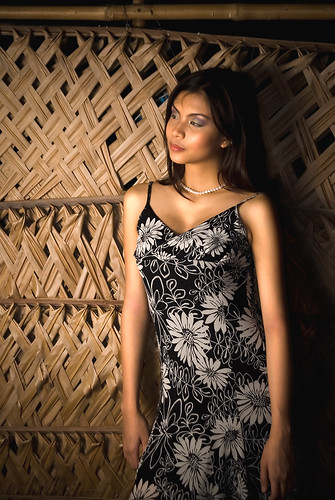 Edited to add: This post is in no way normative. I am not making value judgments on what should be. I guess I need to put a context to this post. It comes from me looking at photos of young Filipinas in search of foreigner husbands on the online dating site I work for. I do not consider myself a prude, but some of the photos enrage and sadden me. I do my best to edit unnecessary cleavage, or just crop the upper half of whole body shots of young women in skimpy outfits. The photo below is actually very tasteful, it is a mere hint of some of the photos we get. By far, most photos are head/shoulder shots. Some though, look more like this one on the right. Yes, and that's a German url, so you know to whom this photo is addressed. I'd rather not think of what happens to young Filipinas in the provinces. Really, I'd rather not. I've read news about trafficking and white slavery. I've heard of anecdotes from friends and colleagues. It is a different thing, however, to see their faces.
Edited to add: This post is in no way normative. I am not making value judgments on what should be. I guess I need to put a context to this post. It comes from me looking at photos of young Filipinas in search of foreigner husbands on the online dating site I work for. I do not consider myself a prude, but some of the photos enrage and sadden me. I do my best to edit unnecessary cleavage, or just crop the upper half of whole body shots of young women in skimpy outfits. The photo below is actually very tasteful, it is a mere hint of some of the photos we get. By far, most photos are head/shoulder shots. Some though, look more like this one on the right. Yes, and that's a German url, so you know to whom this photo is addressed. I'd rather not think of what happens to young Filipinas in the provinces. Really, I'd rather not. I've read news about trafficking and white slavery. I've heard of anecdotes from friends and colleagues. It is a different thing, however, to see their faces.--------------------


When you look at the two photos above, you are not merely looking at lines, shapes and colours. Now, probably more than ever, there is truth to the adage - a picture speaks a thousand words. But these photos communicate more than words. They tell a story. They string more pictures together within our brains. They make connect-the-dots associations of concepts and ideas that denote more than the literal message - that they are two young, attractive females.
What does the one on the left tell you? What story do you see unfolding when you look at this photo? Does it tell you where this photo may have been taken? Does it tell you, who this young woman might be? Does it tell you anything about her character? What about the photo on the right? Let's pretend she isn't a well-known celebrity. As she smiles at you, with her Oriental eyes and her European features, what sorts of other images come to mind?
The photo on the left will probably say, it was taken somewhere in the provinces. The woven sawali wall behind here connotes a nipa hut, probably near the beach. She is wearing around her neck what looks like a string of seashells. She has on her face, a relaxed, open look. Just as relaxed as her body. Now, what sorts of other images do these connotations tell you? Do you think, well here is a woman in an idyllic setting. Here she languishes, her shoulders lightly leaning against the woven wall. She's probably looking at the waves crashing and contemplating...something. Contemplating what? Or maybe, dressed up as she is, she's waiting for something or someone. Maybe she's waiting for you? And who are you? Are you a man? Or a woman? Are you perhaps a fellow probinsyana nearby? Are you straight or gay? Are you a weary urbanite from the capital? Or maybe someone who needs a passport to come see her?
Now look at the photo on the right. She obviously has mixed parents. She is not, what some would call, a "pure" Filipina. Would you say, that this photo connotes the exact same messages given by the one on the left? Would you say, this was taken in the provinces somewhere? Probably not. You would think, well this photo was probably taken in the city. Most likely in Manila. Looking at her neatly coiffed hair, her fair skin and toned arms, would you think she denotes the exact same messages as the one on the left? Do you see them switching places? Probably not. More importantly, looking at the woman on the right, who are you?
The seaside idyll of the woman on the left is seductive in its...simplicity. To get away from the chaos of the city, of modernity, you're going back to basics. Its the same kind of thing those characters in "The Beach" are looking for. You're looking for something in the past. Something pure. And here she is, the perfect simple woman. With her long black hair and her willing posture, she would welcome you. You would expect her to be soft and submissive, open to your demands. Would you say she was rich? Would you say, she bought her clothes, put on her make-up and her string of seashells? Probably not. It is artifice. You might think, living in her sawali hut, that she is probably poor. Just as her dark skin tells you she is poor.
What about the woman on the right? Do you think she is poor? Do you think her soft and submissive and languid and waiting in her hut? Waiting for you? Probably not. She looks like she put on her own clothes. She looks like she went to an expensive department store and bought her own make-up. Her arms suggest she probably has money to spend in Fitness First. Does she look like she needs you? Even as she looks you in the eye, do you think she needs rescuing? Or is she more your equal? Not so feminine, so soft, so powerless as the one on the left?
--------
Your might also want to read:
Of Postmodern Sex
Mga Puta

No comments:
Post a Comment